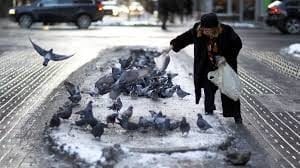
by Pigeon Patrol | Dec 17, 2019 | Bird Netting, Bird Spike, Bird Spikes, Pigeon Control, Pigeon Droppings, Pigeon Patrol's Services, Pigeon Spikes
A Manx bird charity has spoken against Douglas Council’s move to ban mass feeding of wild birds throughout the town.
Manx Wild Bird Aid (MWBA) is calling for the council to follow guidance set out by the Department of Environment, Food and Agriculture (DEFA) on how to manage the pigeon population without leaving them to starve.It also raises concerns about home bird feeders being affected.The council is now seeking approval from Tynwald to amend the Douglas General Byelaws 2013, in particular bylaw 19, which relates to ’feeding of animals and birds’.It wants to extend the current prohibited feeding zone to cover the entire Borough of Douglas.
 The current zone includes; Douglas seafront from the Bottleneck to the war memorial; Mona Terrace; Finch Road; Athol Street; Bridge Road; South Quay and Parade Street; plus areas on Prospect Terrace and Buck’s Road.Those caught flouting the bylaw would be given a fixed penalty notice.David Cole, a founding member of MWBA with his wife Barbara, doesn’t believe the bylaw would protect those who feed birds at home from being fined if a complaint is made against them.He said: ’The trouble is that Douglas Council says the bylaw doesn’t apply to people with bird tables in their gardens. A byelaw doesn’t have any exceptions.’In theory if someone says “the birds in your garden are annoying me” the bird feeder could be liable for a spot fine.’
The current zone includes; Douglas seafront from the Bottleneck to the war memorial; Mona Terrace; Finch Road; Athol Street; Bridge Road; South Quay and Parade Street; plus areas on Prospect Terrace and Buck’s Road.Those caught flouting the bylaw would be given a fixed penalty notice.David Cole, a founding member of MWBA with his wife Barbara, doesn’t believe the bylaw would protect those who feed birds at home from being fined if a complaint is made against them.He said: ’The trouble is that Douglas Council says the bylaw doesn’t apply to people with bird tables in their gardens. A byelaw doesn’t have any exceptions.’In theory if someone says “the birds in your garden are annoying me” the bird feeder could be liable for a spot fine.’
Council leader David Christian said: ’The changes the council is proposing are not about targeting well-meaning householders who have bird tables or garden feeders in their gardens. This we applaud.
’It’s about putting enforcement measures in place to deal with irresponsible individuals who persistently mass-feed birds, especially seagulls.’This is a practice which attracts large concentrations of birds, causes widespread public nuisance and distress and encourages vermin.’It also places undue demands on the council’s street cleansing operations and compromises our efforts to project a positive image for Douglas.’Advice given by the DEFA to local authorities includes having designated feeding areas set up for members of the public to freely feed pigeons and other birds.
In the document ’Advice and Information on Pigeon Control’, it also suggests setting up artificial breeding facilities, which has been said to decrease pigeon populations by as much as 50%.This is achieved by removing eggs that have been laid inside the nesting boxes and replacing them with dummy eggs.We previously reported in May about the worrying decline of seabird populations across the island.A survey was carried out over two years by Manx BirdLife with its 2017-18 census revealing that eight seabird species have suffered significant declines, with population losses of up to 82%.hen asked about this, Mr Cole said: ’We have got to give gulls a helping hand, particularly when it’s cold or during breeding season. When we take away that option [of being fed] it’s going to have an affect on a number of birds.’
He added: ’We deal with sick and injured birds. If there’s a sudden stop in the feeding of birds then a lot of them are going to starve because of it. There’s a lot of distressed birds in the island already.’’Milly would be here’ had Glasgow hospital followed adviceA mother whose daughter died at Scotland’s largest hospital has said her daughter would be still alive had concerns about water contamination risks been addressed in time.Kimberly Darroch was speaking after a leaked inspection report into Glasgow’s Queen Elizabeth University Hospital (QEUH) revealed “high risks” in 2015.
Milly Main, 10, contracted an infection in 2017 while on the hospital campus.She was recovering from leukaemia at the Royal Hospital for Children.
The QEUH 2015 inspection report, which ranked infection control measures as “high risk” in several areas just two days after the hospital opened, was passed to Labour MSP Anas Sarwar by whistleblowers. NHS Greater Glasgow and Clyde (NHSGGC) insisted the hospital campus had a “safe and effective water supply” and all inspection reports had been acted upon.
Warning of ‘high risk’ to water supply at hospitalHospital infection spiked at time of child’s deathMs Darroch told BBC Scotland on Thursday night: “I’m shocked with the information that came out today. The fact that they’ve known since since 2015, it’s absolutely disgusting that nothing was done about it and no action was taken and the hospital was still opened.
“I believe Milly would still be here if action had been taken. I’ve no doubt in my mind that Milly would be sitting beside me, right now.”There is no words to describe that pain of knowing that if things had been different, that if things had been sorted with the water, she would still be here.”I think the health board needs to be held to account for the mistakes that they made.”
She added: “We wouldn’t have been made aware of any of this if it wasn’t for the whistleblower coming forward.”I think there will continue to be shocking revelations for the foreseeable future.”
Kimberly Darroch said the leaked report had “shocked” herA spokesperson said the Scottish government was “examining in detail” the separate material Mr Sarwar had highlighted.
They added: “We want to ensure that all families who have been affected can get the answers that they are clearly entitled to and the health secretary has given her personal assurance that she will ensure this happens.”We are committed to making sure that these matters are dealt with transparently and with clear accountability, which is one of the reasons the health secretary has instructed a public inquiry in these matters to be chaired by Lord Brodie.”Ms Darroch said she was “very angry” and felt the health board had swept the case “under the carpet”.
A hospital complaints manager had contacted her on Thursday but she had not received an apology, she said.
Milly, who had leukaemia, underwent a successful stem cell transplant in July 2017 and was making a good recovery when the following month her Hickman line, a catheter used to administer drugs, became infected. Milly went into toxic shock and died days later.
Her death certificate lists a Stenotrophomonas infection of the Hickman line among the possible causes of death but Ms Darroch says the family were kept in the dark about a potential link to contaminated water problems at the hospital.
A spokeswoman for NHS Greater Glasgow and Clyde said: “We are very sorry for the ongoing distress that has been caused to Ms Darroch and we want to provide parents with as much support as possible.”We are in contact with Ms Darroch and would like to meet her to answer her questions if she would be happy to do that.”
The Legionella assessment was carried out by private contractor DMA Water Treatment two days after the hospital openedIn the Scottish Parliament, Mr Sarwar said he had seen figures which suggested there were 50 cases of infections at the Royal Children’s Hospital – part of the £842m QEUH campus – between 2015 and 2018, and a further 15 unconfirmed cases so far this year.
ressed on the warnings at first minister’s questions, Nicola Sturgeon said she was determined to get the “answers parents deserve”.The documents seen by Mr Sarwar show that NHS Estates commissioned three separate independent reports into the water supply at the QEUH.
The first Legionella assessment, carried out by private contractor DMA Water Treatment on 29 April 2015 – two days after the hospital welcomed its first patients – categorised the management of the bacteria as “high risk” because there was “significant communication issues between the parties” responsible for managing the risk.
The problem of contaminated water is one of a number to beset the Queen Elizabeth University Hospital (QEUH) and the adjoining Royal Hospital for Children.
Last year, two cancer wards at the children’s hospital were shut because of concerns about infection, and children were moved to the QEUH instead. An inquiry by Health Protection Scotland later identified 23 potential water supply-linked infections during 2018.In January it emerged two patients at the QEUH had died after contracting an infection linked to pigeon droppings.
City to remove hundreds of tonnes of pigeon poop from Sid Buckwold BridgeSaskatoon has a pigeon poop problem. A heavy one.
Since it opened in 1966, a flock of around 1,500 pigeons has called the Senator Sid Buckwold Bridge home. Over the last five decades, the city estimates that 348 tonnes of pigeon droppings have accumulated in the crevices and cavities of the 183-metre bridge.
Now, as part of a two-year plan to rehabilitate the concrete river crossing, the city is preparing to spend around $800,000 on specialized contractors who will capture and euthanize the pigeons, then manually remove 53 years worth of their feces.The next step will be to ensure pigeons can’t return, because the feces adds significantly to the bridge’s dead load and the uric acid in the droppings can eat into concrete and rebar, according to the city’s general manager of transportation and construction.
The droppings weigh as much as 232 mid-sized cars — within the limits for which the bridge is rated, but a potential concern should nothing be done, Angela Gardiner said Friday in an interview. Large piles of pigeon droppings also have potential health implications.
“There’s no immediate concern about the integrity of the bridge; it’s just the long-term potential that it could cause over a number of years and decades,” she said, adding that there is no indication the uric acid has damaged the bridge’s structure.
The city expects the work to begin next week. The first phase — trapping and euthanizing the birds — is slated to last about six weeks, while the “labour-intensive” cleaning is likely to continue through the summer and into the fall, Gardiner said.
Once the bridge is clean, the city plans to install barriers to ensure pigeons can’t return to the cavities and utility conduit under the span. Gardiner acknowledged that it’s impossible to completely eliminate the pigeons, but said the city will do what it can to keep them away.
While the city plans to keep an eye on its other major pieces of infrastructure, the Buckwold Bridge is thought to be particularly hospitable for pigeons. The city’s other bridges offer the birds far fewer opportunities to nest.
Pigeons are well-known pests that damage private property as well as municipal infrastructure. They are also thought to be among the most destructive; few other species are capable of causing as much damage.
“This job comes with a lot of new and unique things. Each project is different. We were aware there were pigeons (and) an issue with this bridge. But the extent of it is a lot bigger than I thought anyone anticipated,” Gardiner said.amacpherson@postmedia.com
About Pigeon Patrol:
Pigeon Patrol Products & Services is the leading manufacturer and distributor of bird deterrent (control) products in Canada. Pigeon Patrol products have solved pest bird problems in industrial, commercial, and residential settings since 2000, by using safe and humane bird deterrents with only bird and animal friendly solutions. At Pigeon Patrol, we manufacture and offer a variety of bird deterrents, ranging from Ultra-flex Bird Spikes with UV protection, Bird Netting, 4-S Gel and the best Ultrasonic and audible sound devices on the market today.
Contact us at 1- 877– 4– NO-BIRD, (604) 585-9279 or visit our website at www.pigeonpatrol.ca
Bird Gone, Pigeon Gone, Seagull Gone, Pigeon problems, pigeon spikes, 1-877-4NO-BIRD, 4-S Gel, Bird Control, Pigeon Control, bird repellent, Bird Spikes, sonic bird repellent, stainless steel bird spikes, bird spikes Vancouver, Ultra Sonic Bird Control, Bird Netting, Plastic Bird Spikes, Canada bird spike deterrents, Pigeon Pests, B Gone Pigeon, Pigeon Patrol, pest controller, pest control operator, pest control technician, Pigeon Control Products, humane pigeon spikes, pigeon deterrents, pigeon traps, Pigeon repellents, Sound & Laser Deterrents, wildlife control, raccoon, skunk, squirrel deterrent, De-Fence Spikes, Dragons Den, Canada bird spikes, Canada pigeon, pigeon control, pidgon patrol, pidgon. Kill pigeons, crow, starling

by Pigeon Patrol | Dec 17, 2019 | Bird Netting, Bird Spike, Bird Spikes, Pigeon Control, Pigeon Droppings, Pigeon Patrol's Services, Pigeon Spikes, Pigeons in the News, UltraSonic Bird Control
Stop the pigeons! Birds fed birth-control drug at SkyTrain station to reduce population
Pigeons can seem pretty innocuous in the city, but according to TransLink, the birds can cause all kinds of problems along the SkyTrain system. Now, along with the BC SPCA, TransLink is testing a birth control drug on the birds to reduce the population. To start, there’s the issue of poop. CBC News first reported in December that pigeon droppings had dogged the transit authority as it prepared to open a new platform at the Commercial-Broadway station. TransLink has a poopy pigeon problem on its hands at new Expo Line platform
The problems don’t just revolve around the nasty mess. According to TransLink, pigeons can interfere with the transportation system, causing SkyTrain delays when they trigger track intrusion alarms, and automatic brakes are activated. TransLink has tried to discourage the birds from roosting in its stations. The spikes installed along perches didn’t do it. Nor did low-voltage strips or netting. According to TransLink, a falconer has been hired to make the rounds at pigeon-plagued stations to scare off the birds. But according to spokesperson Jill Drews, what’s needed is a long term solution. Along with the BC SPCA, TransLink is testing a feeding system that distributes corn laced with a contraceptive called OvoControl. Sara Dubois, chief scientific officer with BC SPCA shows the feeding unit placed at the VCC-Clark SkyTrain station. (Michaële Perron-Langlais/CBC) The drug has to be eaten daily to keep the pigeons from laying fertilized eggs, and its effects are reversible.”We’re going to be working with the SPCA here at VCC-Clark for a few weeks and determine the effectiveness and hopefully roll out the feeders at other stations soon,” said Drews.
‘Disruptive and inconvenient’: Granville SkyTrain station escalator shutdown to last 2 years According to Sara Dubois, chief scientific officer with BC SPCA, the drug breaks down in the pigeons’ blood stream and won’t affect any predators that may eat the birds, nor any mammals in the area. “It’s safe; it’s not toxic. It was approved by Health Canada last year. We’ve been waiting for several years for it to come to Canada,” said Dubois. Pigeons seem harmless, but according to TransLink they’re a big problem. Their droppings make a mess of transit platforms, and they can trigger intrusion alarms, causing trains to automatically brake, leading to delays. (Rafferty Baker/CBC) “The goal’s not to get rid of pigeons, the goal is to manage the pigeon situation to the point where it’s not causing problems for TransLink,” she said. Dubois said the results of the pilot program will be carefully tracked, both in terms of whether the birds are consuming the drugged food, but also the number of track intrusion alarms set off by pigeons. Drews said that people are partly to blame for the number of pigeons around SkyTrain stations.
“We would like to tell our customers that we would really like it if they stop feeding birds near our stations,” she said. “It isn’t good for the pigeons — they’re best off to find their own natural food — and it isn’t good for our customers, because it caused delays and unsightly health hazard mess in our stations.” With files from Michaële Perron-Langlais. Follow Rafferty Baker on Twitter: @raffertybaker
About Pigeon Patrol:
Pigeon Patrol Products & Services is the leading manufacturer and distributor of bird deterrent (control) products in Canada. Pigeon Patrol products have solved pest bird problems in industrial, commercial, and residential settings since 2000, by using safe and humane bird deterrents with only bird and animal friendly solutions. At Pigeon Patrol, we manufacture and offer a variety of bird deterrents, ranging from Ultra-flex Bird Spikes with UV protection, Bird Netting, 4-S Gel and the best Ultrasonic and audible sound devices on the market today.
Contact us at 1- 877– 4– NO-BIRD, (604) 585-9279 or visit our website at www.pigeonpatrol.ca
Bird Gone, Pigeon Gone, Seagull Gone, Pigeon problems, pigeon spikes, 1-877-4NO-BIRD, 4-S Gel, Bird Control, Pigeon Control, bird repellent, Bird Spikes, sonic bird repellent, stainless steel bird spikes, bird spikes Vancouver, Ultra Sonic Bird Control, Bird Netting, Plastic Bird Spikes, Canada bird spike deterrents, Pigeon Pests, B Gone Pigeon, Pigeon Patrol, pest controller, pest control operator, pest control technician, Pigeon Control Products, humane pigeon spikes, pigeon deterrents, pigeon traps, Pigeon repellents, Sound & Laser Deterrents, wildlife control, raccoon, skunk, squirrel deterrent, De-Fence Spikes, Dragons Den, Canada bird spikes, Canada pigeon, pigeon control, pidgon patrol, pidgon. Kill pigeons, crow, starling

by Pigeon Patrol | Dec 17, 2019 | Bird Deterrent Products, Bird Netting, Bird Spike, Bird Spikes, Pigeon Droppings, Pigeon Patrol's Services, Pigeon Spikes, Pigeons in the News
An Aerial view The City’s downtown core in Regina, SK. on Thursday, August 22, 2013. Salthaven West director of rehabilitation, Megan Lawrence, believes some downtown businesses may be putting out poison to deter pigeons. Several Regina pest control companies contacted by the Leader-Post said they do offer Avitrol, but it can only be administered in commercial and industrial areas and isn’t for retail sale. A trained pest control employee must administer it.
Instead of poison, Lawrence recommends removing structures where pigeons could roost and screen off air conditioning units where they might drink water from. Bristling wires, which prevent pigeons from landing, can also be purchased from a pest control retailer and installed.“If they’re up on the roof and you start seeing them build nest, remove all nesting materials,” she said. “The more times that happens they’re going to realize this isn’t a place (they can) nest.”
Saskatoon woman says people may be using neurotoxin to poison local pigeons
A Saskatoon woman who helps restore injured birds to health is calling on the City of Saskatoon to help curb a trend she says concerns her. Jan Shadick runs Living Sky Wildlife Rehabilitation. She says that since Jan. 1, people have called her about 35 dead pigeons. 
Rate of ‘kidnapped’ baby hares a concern in Saskatoon Based on the symptoms described, Shadick says she “strongly suspects” most of those birds were poisoned.
“The pigeons are convulsing. They’re having seizures,” she said. “One woman contacted me about a dead pigeon in her yard. I think it was in a flower pot and she was concerned because her dog goes out in the yard.” “It’s an animal. It’s a life. And I don’t think it should suffer,” said Shadick. (Guy Quenneville/CBC) Shadick said she believes a particular neurotoxin used to repel birds is to blame. In a public letter to city councillors, she said Saskatoon Light and Power has used that neurotoxin in the past. Brendan Lemke, the acting director of Saskatoon Light and Power, said, “SL&P does not use poison to kill pigeons in or around its substations. “It has, in the past and consistent with best practices, retained the expertise of pest control experts which have used widely accepted chemical repellents for pigeon control, but SL&P has not used those products or services since 2017.” Shadick wants the city to ban use of the product by anyone in the city.
“It’s an animal. It’s a life. And I don’t think it should suffer,” Shadick said Thursday as she grasped a dead pigeon wrapped in a plastic baggie.
Saskatchewan’s Ministry of Environment said it has not granted a permit for the use of the neurotoxin and would only do so “in exceptional circumstances.”
About Pigeon Patrol:
Pigeon Patrol Products & Services is the leading manufacturer and distributor of bird deterrent (control) products in Canada. Pigeon Patrol products have solved pest bird problems in industrial, commercial, and residential settings since 2000, by using safe and humane bird deterrents with only bird and animal friendly solutions. At Pigeon Patrol, we manufacture and offer a variety of bird deterrents, ranging from Ultra-flex Bird Spikes with UV protection, Bird Netting, 4-S Gel and the best Ultrasonic and audible sound devices on the market today.
Contact us at 1- 877– 4– NO-BIRD, (604) 585-9279 or visit our website at www.pigeonpatrol.ca
Bird Gone, Pigeon Gone, Seagull Gone, Pigeon problems, pigeon spikes, 1-877-4NO-BIRD, 4-S Gel, Bird Control, Pigeon Control, bird repellent, Bird Spikes, sonic bird repellent, stainless steel bird spikes, bird spikes Vancouver, Ultra Sonic Bird Control, Bird Netting, Plastic Bird Spikes, Canada bird spike deterrents, Pigeon Pests, B Gone Pigeon, Pigeon Patrol, pest controller, pest control operator, pest control technician, Pigeon Control Products, humane pigeon spikes, pigeon deterrents, pigeon traps, Pigeon repellents, Sound & Laser Deterrents, wildlife control, raccoon, skunk, squirrel deterrent, De-Fence Spikes, Dragons Den, Canada bird spikes, Canada pigeon, pigeon control, pidgon patrol, pidgon. Kill pigeons, crow, starling
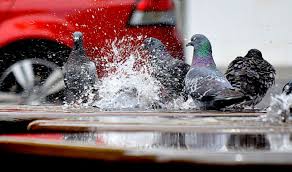
by Pigeon Patrol | Dec 17, 2019 | 4-S Gel Bird repellent, Animal Deterrent Products, Bird Deterrent Products, Bird Netting, Pigeon Droppings, Pigeon Patrol's Services
LAS VEGAS (KSNV) — A unanimous vote has officially made it illegal to feed the pigeons in public in the City of Las Vegas.
Ward 1 councilwoman Lois Tarkanian sponsored the bill. She said the city received numerous complaints about pigeon problems, and it came down to a health issue. Their droppings, she says, can be toxic and can even carry diseases.
News 3 spoke with a pest control expert who explained that when people feed pigeons, more pigeons will show up and expect food at that location. they flock there, reproduce, and thus create more waste.
Meanwhile, the expert says, that food source disappears, but the pigeons don’t necessarily leave. As a result, the street feeders have created a problem for the pigeons.
This may sound like a silly crime — but there are similar laws in place in Henderson and in Clark County.
It does bring up the question — how does the city plan on enforcing it?
Well, if you’re caught feeding them on the streets, there is a chance you’d be reported to the city.
Violators of the new pigeon law could face fines up to $1,000 and even up to six months behind bars.
About Pigeon Patrol:
Pigeon Patrol Products & Services is the leading manufacturer and distributor of bird deterrent (control) products in Canada. Pigeon Patrol products have solved pest bird problems in industrial, commercial, and residential settings since 2000, by using safe and humane bird deterrents with only bird and animal friendly solutions. At Pigeon Patrol, we manufacture and offer a variety of bird deterrents, ranging from Ultra-flex Bird Spikes with UV protection, Bird Netting, 4-S Gel and the best Ultrasonic and audible sound devices on the market today.
Contact us at 1- 877– 4– NO-BIRD, (604) 585-9279 or visit our website at www.pigeonpatrol.ca
Bird Gone, Pigeon Gone, Seagull Gone, Pigeon problems, pigeon spikes, 1-877-4NO-BIRD, 4-S Gel, Bird Control, Pigeon Control, bird repellent, Bird Spikes, sonic bird repellent, stainless steel bird spikes, bird spikes Vancouver, Ultra Sonic Bird Control, Bird Netting, Plastic Bird Spikes, Canada bird spike deterrents, Pigeon Pests, B Gone Pigeon, Pigeon Patrol, pest controller, pest control operator, pest control technician, Pigeon Control Products, humane pigeon spikes, pigeon deterrents, pigeon traps, Pigeon repellents, Sound & Laser Deterrents, wildlife control, raccoon, skunk, squirrel deterrent, De-Fence Spikes, Dragons Den, Canada bird spikes, Canada pigeon, pigeon control, pidgon patrol, pidgon. Kill pigeons, crow, starling

by Pigeon Patrol | Dec 16, 2019 | 4-S Gel Bird repellent, Animal Deterrent Products, Bird Netting, Bird Spikes, Pigeon Control, Pigeon Droppings, Pigeon Patrol's Services, Pigeon Spikes, Pigeons in the News
The Standing Policy Committee on Environment, Utilities and Corporate Services on Monday reviewed a report prepared in response to a request by Living Sky Wildlife Rehabilitation.
The centre asked the city to stop using the neurotoxin, saying it’s an inhumane way to control pests.
Around 2,300 pigeons put down, 635,000 kg of feces cleaned from Saskatoon bridge
According to a description on Avitrol’s website, the product works by causing “behaviours similar to an epileptic seizure.”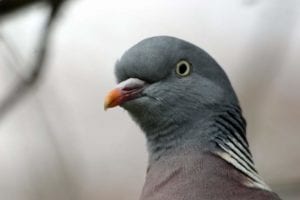
“This may include flying erratically, vocalizing, trembling, dilation of the pupils and other symptoms,” the description says.
Witnessing these behaviours can encourage unaffected birds to leave a location.
“Flocks can be frightened away from sites little or no mortality.”
According to the report, Avitrol is no longer used in other cities including Halifax, San Francisco and New York.
The committee heard how in the past the city used Avitrol to remove pests, but currently there are no sites where the city or its contractors are using the poison.
However the city does not have anything in writing that bans private use of Avitrol.
City hall to pursue pest management strategy for Saskatoon
Concern is raised over the city’s use of neurotoxins to control pigeon populations
PHIL TANK, SASKATOON STARPHOENIX
About Pigeon Patrol:
Pigeon Patrol Products & Services is the leading manufacturer and distributor of bird deterrent (control) products in Canada. Pigeon Patrol products have solved pest bird problems in industrial, commercial, and residential settings since 2000, by using safe and humane bird deterrents with only bird and animal friendly solutions. At Pigeon Patrol, we manufacture and offer a variety of bird deterrents, ranging from Ultra-flex Bird Spikes with UV protection, Bird Netting, 4-S Gel and the best Ultrasonic and audible sound devices on the market today.
Contact us at 1- 877– 4– NO-BIRD, (604) 585-9279 or visit our website at www.pigeonpatrol.ca
Bird Gone, Pigeon Gone, Pigeon problems, pigeon spikes, 1-877-4NO-BIRD, 4-S Gel, Bird Control, Pigeon Control, bird repellent, Bird Spikes, sonic bird repellent, stainless steel bird spikes, bird spikes Vancouver, Ultra Sonic Bird Control, Bird Netting, Plastic Bird Spikes, Canada bird spike deterrents, Pigeon Pests, B Gone Pigeon, Pigeon Patrol, pest controller, pest control operator, pest control technician, Pigeon Control Products, humane pigeon spikes, pigeon deterrents, pigeon traps, Pigeon repellents, Sound & Laser Deterrents, wildlife control, raccoon, skunk, squirrel deterrent, De-Fence Spikes, Dragons Den.
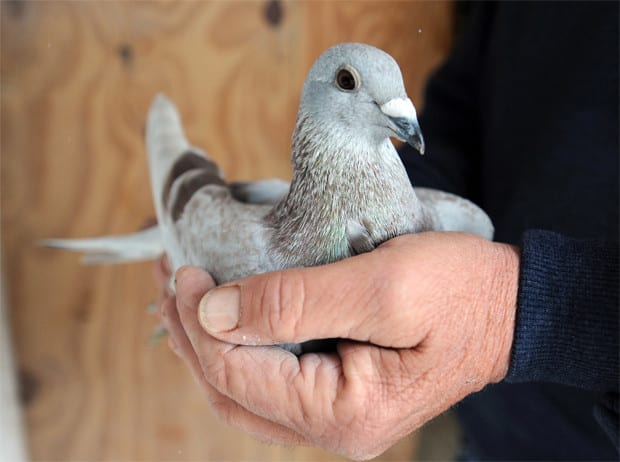
by Pigeon Patrol | Oct 22, 2019 | Bird Deterrent Products, Pigeon Control, Pigeon Droppings, Pigeon Patrol's Services, Pigeon Spikes
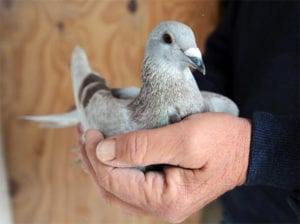
Pigeon in New York City (file / credit: STAN HONDA/AFP/Getty Images)
EOGHAN MacCONNELL
HAND-REARED live pigeons were coated in poison, tethered to the ground and used to kill two wild buzzards near the Tipperary-Offaly border, according to BirdWatch Ireland.
BirdWatch volunteers were horrified to discover the two dead buzzard chicks beside three poisonous tethered pigeons near Roscrea.
BirdWatch Ireland Development Officer Niall Hatch said the banned insecticide Carbofuran used to kill the buzzards is so toxic “a quarter of a teaspoonful is enough to kill a fully grown adult”.
“There is a really serious public safety issue here as well,” he said, “whoever is responsible for planting the poison took a real risk themselves”. Had the pigeons been found by children who attempted to rescue them, “you could be reporting on an even worse story today,” he added.
No motive has yet been established. Buzzards eat rabbits, crows, magpies, rats and mice. They will occasionally feed on a dead lamb, but are incapable of killing a lamb, said Mr Hatch.
An indigenous bird, the buzzard was absent in Ireland from the late 19th century until 1933, when a pair bred in Co Antrim. The species has spread slowly down from the north through the 20th century and is now established in almost every county in Ireland.
BirdWatch Ireland say this was a particularly abhorrent incident.
The live hand-reared pigeons were tethered to the ground as bait, their bodies coated with poison and their wings clipped to prevent any chance of escape.
A day after the dead buzzards were found last month, another live, poison-coated pigeon was discovered tethered in the same area.
The buzzards’ nest in Roscrea was being monitored by two young volunteers from BirdWatch Ireland’s Raptor Conservation Project since early spring. They had been charting the progress of the three young buzzard chicks.
One volunteer said: “we had been watching them all summer and it was sickening to see them killed like that for no reason”.
The farmer on whose land the birds were nesting said: “they have not caused me or any of the other farmers in the area any problems whatsoever. I gave nobody permission to come on my land and lay down poison, and whoever did so was trespassing,” he said.
In October 2010, laws were passed making it illegal to use poison to kill birds or animals, with the exception of rats and mice.
An investigation has been launched and anyone with information is urged to contact the National Parks and Wildlife Service on 057 91 37811 or Birr Garda station on 057 91 69710.
About Pigeon Patrol:
Pigeon Patrol Products & Services is the leading manufacturer and distributor of bird deterrent (control) products in Canada. Pigeon Patrol products have solved pest bird problems in industrial, commercial, and residential settings since 2000, by using safe and humane bird deterrents with only bird and animal friendly solutions. At Pigeon Patrol, we manufacture and offer a variety of bird deterrents, ranging from Ultra-flex Bird Spikes with UV protection, Bird Netting, 4-S Gel and the best Ultrasonic and audible sound devices on the market today.
Contact us at 1- 877– 4– NO-BIRD, (604) 585-9279 or visit our website at www.pigeonpatrol.ca
Bird Gone, Pigeon Gone, Pigeon problems, pigeon spikes, 1-877-4NO-BIRD, 4-S Gel, Bird Control, Pigeon Control, bird repellent, Bird Spikes, sonic bird repellent, stainless steel bird spikes, bird spikes Vancouver, Ultra Sonic Bird Control, Bird Netting, Plastic Bird Spikes, Canada bird spike deterrents, Pigeon Pests, B Gone Pigeon, Pigeon Patrol, pest controller, pest control operator, pest control technician, Pigeon Control Products, humane pigeon spikes, pigeon deterrents, pigeon traps, Pigeon repellents, Sound & Laser Deterrents, wildlife control, raccoon, skunk, squirrel deterrent, De-Fence Spikes, Dragons Den.

 The current zone includes; Douglas seafront from the Bottleneck to the war memorial; Mona Terrace; Finch Road; Athol Street; Bridge Road; South Quay and Parade Street; plus areas on Prospect Terrace and Buck’s Road.Those caught flouting the bylaw would be given a fixed penalty notice.David Cole, a founding member of MWBA with his wife Barbara, doesn’t believe the bylaw would protect those who feed birds at home from being fined if a complaint is made against them.He said: ’The trouble is that Douglas Council says the bylaw doesn’t apply to people with bird tables in their gardens. A byelaw doesn’t have any exceptions.’In theory if someone says “the birds in your garden are annoying me” the bird feeder could be liable for a spot fine.’
The current zone includes; Douglas seafront from the Bottleneck to the war memorial; Mona Terrace; Finch Road; Athol Street; Bridge Road; South Quay and Parade Street; plus areas on Prospect Terrace and Buck’s Road.Those caught flouting the bylaw would be given a fixed penalty notice.David Cole, a founding member of MWBA with his wife Barbara, doesn’t believe the bylaw would protect those who feed birds at home from being fined if a complaint is made against them.He said: ’The trouble is that Douglas Council says the bylaw doesn’t apply to people with bird tables in their gardens. A byelaw doesn’t have any exceptions.’In theory if someone says “the birds in your garden are annoying me” the bird feeder could be liable for a spot fine.’






